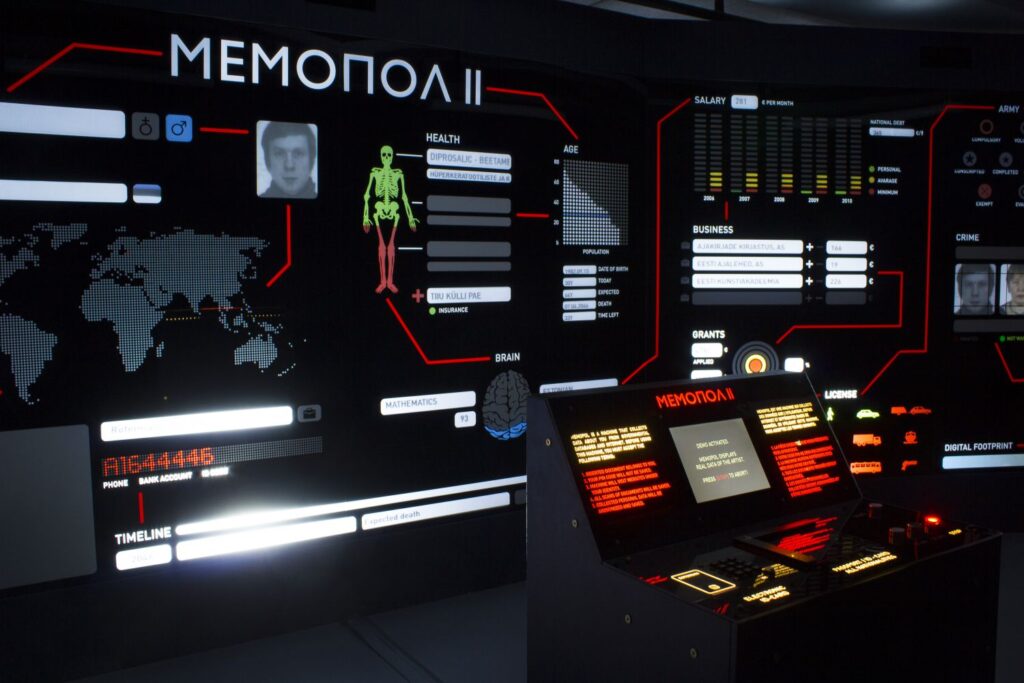
Timo Toots (1982) is an interdisciplinary artist, who creates interactive installations, which deal with social behavioural patterns, information fields and virtuality. His work problematizes the impact of technological advancements on society and the individual’s life quality.
One of the first works by Toots which exemplifies the relationship between a human being and technology was “Media Bubble” (2008). It created a media landscape around the spectator, in which titles from international and local media were projected. The more rapid one swirls on the plate, the more media foam will appear around the spectator and on the floor.
Interactive installation “Hall of Fame” (2009) maps the personal information field and calculates ones social position based on an ID-card. If “Hall of Fame” leaves a rather playful impression due to its ability to generate pseudo data, its advancement “Memopol-II” (2011-2013) is much more powerful, displaying information not only found from the internet, but also governmental databases. For evaluating one’s digital footprint, you’d have to insert your ID-card with PIN-code to the machine or scan your passport. One of the ideas of “Memopol”, is to show the same tools which are present in our everyday life, in a different aesthetic register. “Memopol-III” (2018) collects information in addition to the aforementioned databases also from smartphone and cloud services. The installation will be exhibited in KUMU at the exhibition “Archaeology of The Screen”.
The vulnerability of an individual trusting technological devices, is expressed in Toots’ exhibition “Z” (2014), in which the perception of reality and sense of danger for the exhibition guest was manipulated. By using infrared-sensitive screens, a completely different reality is exposed rather than looking with a naked eye. In the centre of the spatial installation was a (cyber) police car, which acquired different properties than when looking through the screen.
Urban space project “Soodevahe” (2009–2011) introduced an undiscovered milieu-valuable illegal settlement behind Tallinn airport in an area of summer cottages. Previously, Toots had turned a dacha into an airport monitoring centre, which he named “Linnujaam”. For the increasing number of tourists he also founded the museum SoMu, bar, DIY hotel Baldahhiin and Cotton Theatre. This self-imposed network of institutions has now been demolished.
From a similar self-imposition and motivation for freedom, Toots has founded the art residency Maajaam (since 2013) near Otepää, which focuses on the synthesis of nature and technology. By substituting urban context with hilly rural surrounding, the hi-tech artworks exhibited there gain an amplified experience.
Toots has created also public sculptures like “Wind Poetry” (2016), which consists of two “book sheets” on a metal construction. Its content is made from black and white “wind pixels”. If the wind blows through the “book”, it gets the pixels rotating, creating a sound and new patterns of poetry.
Timo Toots studied informatics in Tartu University and photography in the Estonian Academy of Arts (BA, 2009). During his studies he was an exchange student at Iceland University of Arts and Karlsruhe University of Arts and Design. He has had several personal and group exhibitions in Europe and Estonia. He has been awarded with the prestigious Ars Electronica Golden Nica (2012) and Annual Prize of The Cultural Endowment of Estonia (2012).